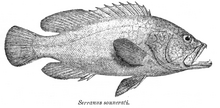| Cephalopholis sonnerati | |
|---|---|

| |
| Conservation status | |
 Least Concern (IUCN 3.1) | |
| Scientific classification | |
| Domain: | Eukaryota |
| Kingdom: | Animalia |
| Phylum: | Chordata |
| Class: | Actinopterygii |
| Order: | Perciformes |
| Family: | Serranidae |
| Subfamily: | Epinephelinae |
| Genus: | Cephalopholis |
| Species: | C. sonnerati |
| Binomial name | |
| Cephalopholis sonnerati (Valenciennes, 1828) | |
| Synonyms | |
| |


Cephalopholis sonnerati, known as the tomato hind, tomato rockcod, or tomato cod, is a species of marine ray-finned fish, a grouper from the subfamily Epinephelinae which is in the family Serranidae which also includes the anthias and sea basses. It is distributed on coral reefs in the tropical Indo-Pacific. It is also sometimes called the orange-spotted cod, red coral cod, red rockcod, tomato grouper, or tomato seabass.
Description
Cephalopholis sonnerati has a body which is 2.3 to 2.8 times as long as it is deep using standard length. The dorsal profile of the head in adults is straight to concave, although the nape is markedly convex. The preopercle is rounded and has fine serrations along its margins, with a shallow incision immediately above its angle, the lower edge has irregular serration and some of these are enlarged into small, exposed spines. The dorsal fin contains 9 spines and 14-16 soft rays while the anal fin has 3 spines and 9 soft rays. The caudal fin is rounded. It is a light reddish-brown grouper with a dense covering of rusty spots on its body and a rounded tail with a white margin. The body profile is deep and stout with a dark blotch on the upper region of the gill cover. This species can grow up a maximum length of 57 centimetres (22 in). Pacific Ocean specimens have a generally pale reddish brown to yellowish brown body color , with numerous small dense brownish spots on the head, fins and the body.
Distribution
Cephalopholis sonnerati has an Indo-Pacific distribution which extends from the coast of East Africa from the Gulf of Aden south to Durban in South Africa; east in to the Pacific Ocean as far as the Line Islands, north as far as southern Japan and south to Australia. In Australia it is found from the Houtman Abrolhos in Western Australia to the vicinity of Darwin, Northern Territory and from the Cape York Peninsula, Queensland to the South West Rocks, New South Wales, as well as Lord Howe Island in the Tasman Sea. It is not found in the Chagos Islands, the Red Sea or the Persian Gulf.
Habitat and biology
Cephalopholis sonnerati occurs on deep lagoon reefs, outer reef slopes and in coastal areas with rocky substrate. The juveniles are usually found near sponge or coral heads. It is a solitary species with adults usually being accompanied by cleaner shrimps. They live in moderate depths of 30 to 100 m (98 to 332 ft). It feeds on small fishes and crustaceans. Maturity for males is reached at 34 cm (13 inches ) and 28 cm (11 inches) for females.
Taxonomy
Cephalopholis sonnerati was first formally described as Serranus sonnerati in 1828 by the French zoologist Achille Valenciennes (1794–1864) with the type locality give as Puducherry in India.
Utilisation
This species is of commercial importance and usually sold fresh throughout its range. The tomato hind is caught using hook and line, spear, and in traps. It is found in Hong Kong live reef fish markets.
References
- ^ Sadovy, Y.; Leung Lap Boon, B. (2018). "Cephalopholis sonnerati". IUCN Red List of Threatened Species. 2018: e.T132757A100457871. doi:10.2305/IUCN.UK.2018-2.RLTS.T132757A100457871.en. Retrieved 19 November 2021.
- "Oldstyle id: 6d9bc6de8e3d29af87094f6bc24918c6". Catalogue of Life. Species 2000: Leiden, the Netherlands.
- ^ Froese, Rainer; Pauly, Daniel (eds.). "Cephalopholis sonnerati". FishBase. December 2019 version.
- ^ Heemstra, P.C. & J.E. Randall (1993). FAO Species Catalogue. Vol. 16. Groupers of the world (family Serranidae, subfamily Epinephelinae). An annotated and illustrated catalogue of the grouper, rockcod, hind, coral grouper and lyretail species known to date (PDF). FAO Fish. Synopsis. Vol. 125. FAO, Rome. pp. 55–56. ISBN 92-5-103125-8.
- "Cephalopholis sonnerati – Tomato Cod". www.reeflifesurvey.com. Retrieved 2020-08-25.
- "Cephalopholis sonnerati". Fishes of Australia. Museums Victoria. Retrieved 25 August 2020.
- Eschmeyer, William N.; Fricke, Ron & van der Laan, Richard (eds.). "Serranus sonnerati". Catalog of Fishes. California Academy of Sciences. Retrieved 10 September 2020.
| Taxon identifiers | |
|---|---|
| Cephalopholis sonnerati | |